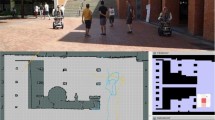Abstract
The characteristic task of service robots that can interact with humans is to achieve human-robot collaboration. Mutual adaptation is considered to be an important characteristic of robots, required for carrying out such collaborative tasks. Here, we introduce the concept of mutual adaptation, propose a learning model, and describe an experimental task to explain the above concept. A waiter robot performs a collaborative task using a platform system, which is developed by a constructive approach. The interactive and manual modes of this system are compared by performing a preliminary experiment to evaluate the effectiveness of the robot’s autonomous function. The results indicate that the robot’s autonomous function works well when operated in the interactive mode under short time or slow speed conditions.
Preview
Unable to display preview. Download preview PDF.
Similar content being viewed by others
References
Thomaza, A.L., Breazeal, C.: Teachable robots: Understanding human teaching behavior to build more effective robot learners. Artificial Intelligence 172(6-7), 716–737 (2008)
Seiji, Y., Koh, K., Takanori, K.: Mutual adaptation and adaptation gap between a human and an agent. Journal of Japanese Society for Artificial Intelligence 21(6), 648–653 (2006)
Xu, Y., Ueda, K., Komatsu, T., Okadome, T., Hattori, T., Sumi, Y., Nishida, T.: Woz experiments for understanding mutual adaptation. Journal of AI& Society 23(2), 201–212 (2009)
Xu, Y., Ohmoto, Y., UedaA, K., Komatsu, T., Okadome, T., Kamei, K., Okada, S., Sumi, Y., Nishida, T.: Two-layered communicative protocol model in a cooperative directional guidance task. In: The 7th International Workshop on Social Intelligence Design, San Juan, Puerto Rico (2008)
Duda, R.O., Hart, P.E., Stork, D.G.: Pattern Classification, 2nd edn. Wiley-Interscience Publication, Hoboken (2001)
Leyton-Brown, K., Shoham, Y.: Essentials of Game Theory - A Concise, Multidisciplinary Introduction. Morgan & Claypool, San Francisco (2008)
Author information
Authors and Affiliations
Editor information
Editors and Affiliations
Rights and permissions
Copyright information
© 2009 Springer-Verlag Berlin Heidelberg
About this paper
Cite this paper
Xu, Y. et al. (2009). A Platform System for Developing a Collaborative Mutually Adaptive Agent. In: Chien, BC., Hong, TP., Chen, SM., Ali, M. (eds) Next-Generation Applied Intelligence. IEA/AIE 2009. Lecture Notes in Computer Science(), vol 5579. Springer, Berlin, Heidelberg. https://doi.org/10.1007/978-3-642-02568-6_58
Download citation
DOI: https://doi.org/10.1007/978-3-642-02568-6_58
Publisher Name: Springer, Berlin, Heidelberg
Print ISBN: 978-3-642-02567-9
Online ISBN: 978-3-642-02568-6
eBook Packages: Computer ScienceComputer Science (R0)




